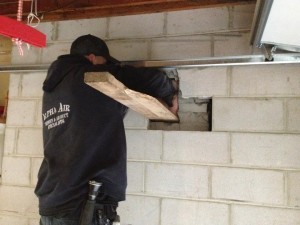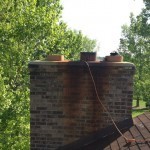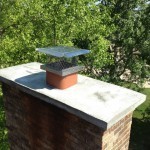Our crew at 2nd Generation Chimneys is trained to detect and protect your family from fire hazards in your chimney, such as replacing  your chimney lining. Non-combustible material is used in the liners we install to protect your home from combustible gas and smoke that can damage or start fires in your chimney. Give us a call today to find out how we can restore your chimney to safe working order with a new liner or other repair. We are here to serve you in St. Paul and the entire Twin Cities area!
your chimney lining. Non-combustible material is used in the liners we install to protect your home from combustible gas and smoke that can damage or start fires in your chimney. Give us a call today to find out how we can restore your chimney to safe working order with a new liner or other repair. We are here to serve you in St. Paul and the entire Twin Cities area!
2nd Generation Chimneys, Inc. Blog: Archive for the ‘Chimney Liner’ Category
Chimney Relining Experts At Work!
Friday, November 9th, 2012Chimney Reline in Minneapolis
Wednesday, July 18th, 2012When it comes to quality Chimney Relining, the Pixley family name has been around for generations and remains the name to trust for all your Chimney cleaning, repair, and inspection needs. David Pixley, owner of 2nd Generation Chimneys, Inc. will ensure the highest quality craftsmanship on your Chimney Relining job. Give us a call today and let the Pixley’s take care of your Chimney needs! See the difference in quality here:
The Importance of a Fully Functional Chimney Liner in Andover
Monday, June 11th, 2012During recent chimney cleaning appointments in Andover we have noticed a few homes that have a “single wythe” chimney style, which means they do not have a chimney liner or chimney flue. These single wythe chimneys only consist of a single layer of brick, which threatens the safety and structure of the entire chimney. Problems venting gases and smoke also quickly arise with these types of chimneys if there are any cracks or structural damage with the chimney. Sparks, ambers and hot smoke can easily escape from these cracks in single wythe chimneys as well.
In many cities across the country it is actually illegal to build a chimney without a chimney liner. There are so many benefits to having a chimney liner that it has become a mandatory aspect of chimneys.
Another old chimney building trend that we have noticed during chimney sweeping assignments is using one chimney column to vent chimney smoke and gases from combustion based heating equipment. This is never a good idea to do because the ventilation of a chimney is not built the same as the ventilation of a fireplace, so the ability for a chimney to remove harmful gases from a home will be reduced.
If you notice a reduction in your chimney’s ability to vent smoke or fumes out of your home it is time to call 2nd Generation Chimneys. We will inspect your entire chimney to determine what the problem is. Whether all you need is a quick chimney cleaning, or a few chimney repairs we will be able to help.
Types of Chimney Liners For Minneapolis
Sunday, April 8th, 2012Many homeowners are shocked to find that there are so many different kinds of chimney liners for Minneapolis homes on the market. Each type of liner is designed and optimized to provide protection for your chimney and home from different types of gasses released at different temperatures. That is why it is so important to have a full chimney inspection completed whenever you upgrade or change your heating system. Here are some of the liner types and what they offer.
- Clay Tile – Clay tile is the most common and inexpensive of flue liners. However, clay tiles are only effective for wood fires and fireplaces as they are not effective in containing the liquid byproducts of high efficiency gas appliances and fireplaces. Additionally, if there is a chimney fire, clay tiles will shatter.
- Stainless Steel – Stainless steel can be cast in multiple shapes, is very flexible and is effective for almost any type of wood furnace or stove. Rarely used in new chimneys, stainless steel is often used for upgrading existing wood-only chimneys.
- Aluminum – Aluminum can be cast to varying degrees of thickness to make it flexible or rigid depending on your needs. It is commonly used to vent gas appliances as it is does a better job of removing liquid byproducts without allowing them to cool since it conducts little heat.
- Cast in Place – Cast in place liners are made from cement-like material that is cast inside the chimney to provide a natural passageway for the gasses being released. Cast-in place liners are good for repairing chimneys that are deteriorating naturally or that have had fires. It works with all types of fuel as well and can add many years of life to a chimney.
As you can see, the type of liner you choose will depend largely on the type of fuel you burn and how you choose to use it. The best option is to talk to 2nd Generation Chimneys about the best option for your particular circumstances and learn what they have to offer.
Why St. Croix County Residents Should Inspect or Replace a Flue Liner When Upgrading a Heating System
Wednesday, March 28th, 2012Despite how they look, most chimneys in St. Croix County can not of handle all forms of exhaust. In fact, when you get your chimney serviced, it is vital to perform chimney flue liner cleaning, and if the chimney flue does not look capable of handling a few more winters, replace it. Here are some details on why this is so important and how you can ensure your family and home are safe with your current chimney.
Condensation and Flue Gasses
If your chimney liner is older and has not been updated in some time, then it is likely not optimized for high efficiency gas boiler or furnaces. Chimneys are designed to do one thing – vent flue gasses. However, since heating systems have become so much more efficient in recent years, they now release flue gasses at much lower temperatures as more heat is extracted from the exhaust.
The result is that gasses being released into your chimney or exhaust pipes are often just barely over the dew point, meaning they will cool in the chimney and condense into liquid – often containing dangerous, corrosive acids that can eat through the flue liner and start to leak through the external structure.
In a single hour of operation, a 150,000 BTU furnace can produce over a gallon of liquid lined with various acids that can eat right through your flue liner and cause damage to your house and present health problems to your family.
Proper Inspection and Upgrade
Not only can an increase in efficiency cause problems, but changing the type of exhaust can as well. Switching from gas to oil for example results in different exhaust and can create a problem with older flue liners.
For all of these reasons it is very important to have your current flue liner inspected for damage and to make sure it is sufficient for a new heating system. If it is not, it should be replaced immediately to ensure it will be enough to handle the gasses being released during combustion. Please call 2nd Generation Chimneys with any questions.


